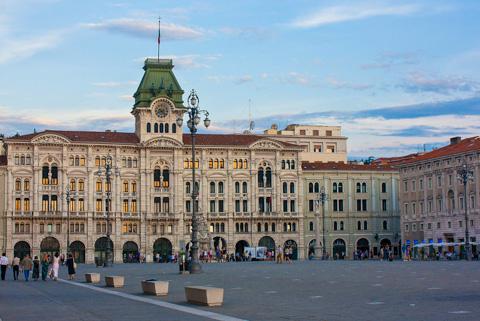Cuisine in Trieste is good, but it's not well known enough to draw in tourists for the restaurant scene. Still, there are a handful of excellent dining spots in the city to discover. It's hard to pinpoint exactly how to categorize the local cuisine. It's been influenced by the city's Austro-Hungarian past and you'll find Austrian, Slovenian, and even Croatian flavors. The food scene is often overlooked for more famous Italian cities, but that doesn't mean there's not a lot to enjoy. Make sure you try jota (a bean, potato, and sauerkraut stew), calandraca (a salted meat stew), and gulasch alla triestina (a local twist on goulash. The city is also a coffee capital in Italy.
When dining out, the average daily cost for food in Trieste is around $63 (€54) per person, with previous travelers spending from $26 to $137. Generally, breakfast and lunch cost less than dinner, but this will depend on the type of restaurant and what you order.
Typical meal prices in Trieste are as follows:
- Breakfast: $6 to $19
- Lunch: $9 to $25
- Dinner: $19 to $44
- Coffee: $5
- Fast Food or Street Food: $9
Local cuisine is reflective of the area's Slavic roots with many dishes consisting of pork, potatoes, cabbage, and stuffed pastries filled with meat for a savory snack or fruit for dessert. A few specialties include a traditional plate of boiled pork called caldaia, a type of dumpling stuffed with meats or fruits called gnocchi, a fish soup called brodetto, a creamy rice called risotto, and a soup called jota that is prepared with pork, potatoes, cabbage, and finely-ground beans. One dish that especially reflects the city's Hungarian roots is goulash, a stew of meat, paprika, and other spices, though the Trieste version omits potatoes and instead includes bread or polenta on the side. Another common side dish is chifeletti, bits of crescent-shaped fried dough made from mashed potatoes, butter, flour, and eggs. Sugar can be added to turn the dish into a dessert.
Within the city, cafes are also very popular. Beginning under Austria-Hungary in the coffee industry, Trieste is still known as the "coffee capital of Italy." On the outskirts of the city are also plenty of opportunities to sample wine, cheese, and pork products from local farms. These wineries are known as "osmicas," after the Slovenian word for eight, since under the Austro-Hungarian Empire farmers were only allowed to open them for eight days each year.
If you're traveling with kids, search for restaurants that offer a children's menu. This can save you a lot of money since these dishes are usually cheaper. Keep in mind that some places may not list their kids' options, so make sure to ask the server.
A lot of hotels include breakfast in their price, but some may add it as an extra charge. The price and quality can differ from one hotel to the next. Being aware of this ahead of time can help you figure out if you'll need to shell out more money. The hotel buffet could be delicious, or you might opt for a more affordable treat at a nearby bakery or cafe.
Fill up a water bottle rather than buying drinks every chance you get. It's also kinder to the earth.
Before embarking on a tour, ensure you know which meals are included. You might have to pay for some food yourself, and that can add to your travel expenses.
If you want to experience the culture in Trieste, a food tour or cooking class is a great way to do it. After all, cuisine is one of the reasons why so many people visit. A few of the best culinary activities here include:
- 5-Course Food Tour with Electric Bikes for $298 details
- Istria - Truffles: Hunting & Cooking & Tasting, Slovenia for $154 details
- Unique Food Tour with Local Flavors and Tastings for $90 details
 Trieste, Italy
Trieste, Italy

 Budget Your Trip is all about finding out how much everything costs so that you can travel cheaper and longer. Created by avid travelers Laurie and Bryan, our goal is to help you plan your next trip on the right budget. With average daily travel costs that are calculated from the budgets of real travelers, plus an analysis of hotel and tour prices, you can find out how much money you need to plan your next adventure. We also have plenty of travel advice, accommodation reviews, and activity suggestions.
Budget Your Trip is all about finding out how much everything costs so that you can travel cheaper and longer. Created by avid travelers Laurie and Bryan, our goal is to help you plan your next trip on the right budget. With average daily travel costs that are calculated from the budgets of real travelers, plus an analysis of hotel and tour prices, you can find out how much money you need to plan your next adventure. We also have plenty of travel advice, accommodation reviews, and activity suggestions.